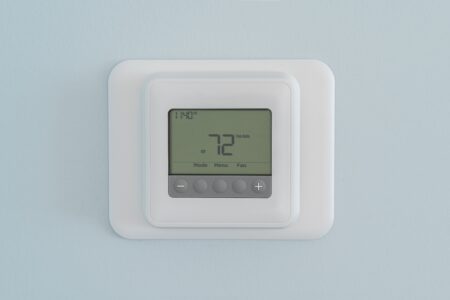
Smart thermostats are a game-changer for energy efficiency. They increase comfort, reduce energy waste, and lower energy bills. It’s imperative to understand their energy-saving features to maximize their benefits.
1. Programmable Scheduling
The ability to customize a smart thermostat’s schedule is essential for making a house more energy efficient. Users can create personalized temperature profiles that take into account their everyday activities. As a result, you can program your HVAC system to maintain your home at more moderate temperatures when no one is home. Scheduling can change the temperature to coincide with when household members are sleeping, working, or at school. This feature allows you to avoid wasting energy on heating and cooling when it’s not needed.
2. Remote Access
Remote access allows homeowners to control their heating and cooling systems with a smartphone app, regardless of their location. For instance, you can use your device to adjust the temperature if you decide to stay out later than usual to visit with friends. This feature also comes in handy if you forget to change the thermostat before leaving on vacation.
3. Geofencing
Smart thermostats use three primary technologies to provide geofencing capabilities. These technologies include GPS, Wi-Fi, and Bluetooth. Whenever a homeowner’s smartphone enters or leaves a specific location, the thermostat receives a signal to adjust the temperature. For example, your thermostat will signal your HVAC system to start bringing your home’s temperature to a comfortable level when you leave work. Geofencing features work exceptionally well for households that have unpredictable schedules.
4. Learning Algorithms
Smart thermostats use adaptive learning algorithms to study the way people use the HVAC system and spot trends in things like temperature changes and occupancy. By actively anticipating preferences, the thermostat increases comfort while minimizing energy use. As the seasons change and people’s habits evolve, the machine learning algorithms adapt by constantly improving their knowledge. Using past data, they are able to make sensible adjustments to the temperature. The designers of smart thermostats included this capability because they realized that homeowners don’t always have the time to stay on top of programming their thermostats manually.
5. Usage Reports
Smart thermostats offer easy-to-understand reports that show how much energy your home uses. These reports break down details like how long your heating or cooling system runs and trends in temperature. By looking at this info, you can make better-informed decisions about when to adjust settings. You can also see how any changes you make affect your energy use, helping you develop more efficient habits for a cost-effective and energy-saving home.
6. Temperature Zoning
Smart thermostats are key to making homes more energy-efficient, especially with HVAC zoning. They work closely with zoned heating and cooling systems to manage temperatures accurately in different areas. They can monitor temperatures for specific zones, ensuring comfort based on occupancy. This means heating or cooling only the rooms in use and avoiding the unnecessary conditioning of spaces like empty guest rooms.
7. Weather Forecast Integration
Smart thermostats receive meteorological data in real-time through Wi-Fi and other internet-connected platforms. They use their weather integration feature to make predictions and modify heating and cooling in advance to match expected weather conditions. For instance, after a cold snap in winter, the system will decrease the temperature in your home before the arrival of milder weather.
8. Occupancy Sensors
Depending on the model, many smart thermostats improve energy efficiency by using various technologies to detect when family members are home and what room they are in. Models with infrared sensors use heat signature technology, while others detect sounds to determine if a space in your residence is occupied. Alternatively, systems with microwave sensors emit pulses to measure reflections caused by moving household members. If you have a smart thermostat with detection technology, the system only heats and cools the rooms with people in them, saving energy and making the home much more energy-efficient.
9. Energy-Efficient Mode
Several energy-saving settings are available on smart thermostats that can help users save money on their utility bills. The “Away” mode is a popular choice; it reduces energy waste by adjusting the temperature when no one is home. “Eco” or “Energy-Saving” modes optimize settings by adjusting temperature parameters to minimize energy consumption. They accomplish this by more gradually heating or cooling your home compared to when the thermostat is in normal mode.
Contact the Professionals
Since 1964, Simmons Heating & Cooling has been serving the residents of Chesapeake, VA. We install, maintain, and repair heating and cooling systems. In addition, we provide indoor air quality and generator services. Contact us today to learn how a smart thermostat can benefit your household.

 view specials
view specials BOOK ONLINE
BOOK ONLINE